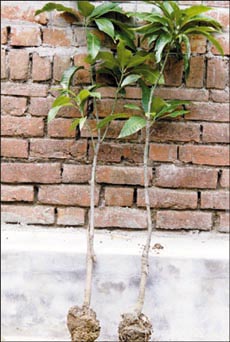This fortnightly
feature was published on August 9
Beware of spurious plants
By Satish
Narula
A gardener is most disappointed when the fruit plants that he had planted, grow
for a few months or even a year or two but die suddenly
without any apparent cause. It is all the more
frustrating when, by any chance, if such plants do
survive after years of costly input and loving care, they
bear little poor quality fruit. That is some thing the
gardener never bargained for. the fruit plants that he had planted, grow
for a few months or even a year or two but die suddenly
without any apparent cause. It is all the more
frustrating when, by any chance, if such plants do
survive after years of costly input and loving care, they
bear little poor quality fruit. That is some thing the
gardener never bargained for.
Propagating ornamental
indoor or shade-loving plants is easy. But when it comes
to multiplying fruit plants you have to consult an
expert. An excellent performing tree, (both quality and
quantity-wise) is a must for use as a mother plant.
You should also be aware
of the type of rootstock (the lower portion on which
grafting is done) to be used for different fruits. There
is an easy way out. Why not visit a reliable source? The
research station of agricultural universities and
nurseries of state horticulture departments, spread all
over the state and the government registered private
nurseries are the best bet.
Plants are multiplied from
the mother plants of known parentage. You can be sure of
what you will get when once your plant starts bearing
fruit after a few years.
The same question remains
that why do plants disappoint even after a year or two
and die unannounced. Was it a big, nearly four-foot-high
mango tree that you had bought from a nearby private
nursery? You were lured that the "big plant"
would start bearing very fast. The plant was easy to
carry as it hardly had any earthball. The soil of the
earthball looked blackish and rich while the leaves and
stem seemed healthy and growing. One more sign, the graft
union was knotty. You sure had been trapped in buying the
Malihabadi or Saharanpuri mango, the
spurious plant that invades in thousands Punjab, Haryana,
and Chandigarh every year.
Such plants are in fact
raised in clay soil medium and shifted in the nursery
itself at least once. At the time of transporting for the
purpose of carrying more number of plants in a truck, a
minimum possible earthball (gachi) is made. In
this process the small feeder roots, as well as those
responsible for anchorage, are severely damaged.
Such plants survive until
they get nutrition from the earthball attached to it. As
the above ground portion flourishes the damaged root
system is not sufficient to sustain the plant’s food
requirement. As a result, the plant starts drying.
Another sure sign,
indicating a spurious plant, is to examine it after a
period of six months or a year by extracting the dead
plant. You will still have the original earthball (gachi)
intact because it fails to merge with our local soil. The
skin will leave the roots even with a little pull. The
cause is rotting due to retention capacity of excess
moisture.
Grafting of such plants is
done by an obsolete method that is inarching. The graft
union is very weak and high above the ground. Breaking of
such plants at the graft union due to the wind is not
uncommon.
Make sure you buy a
locally produced, medium-sized, disease and insect free
plant of known pedigree from a reliable source. It is
even worth-while visiting a distant place to bring a
single plant rather than "buying"
disappointment. Skip a year if you have to, but plant
only the best.
|

